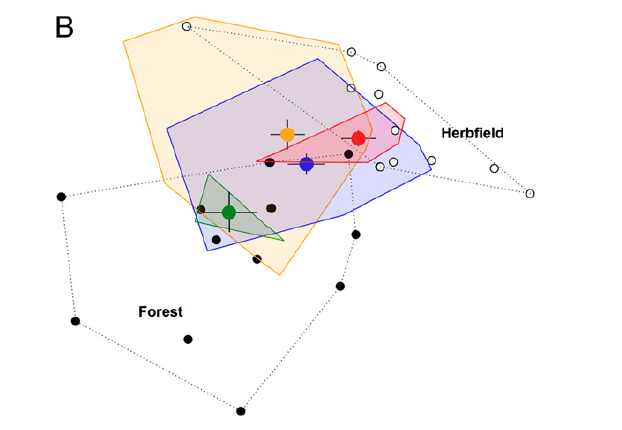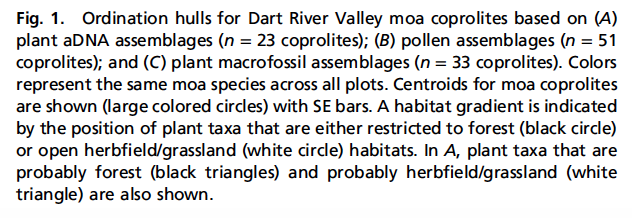1/16 Can you reconstruct past communities from coprolites (fossilized poo)? Yes you can! Our next #RewildingScience study looks at the community structure and feeding ecology of extinct moas from New Zealand and whether they can be replaced for #rewilding diet breadth suggests no
2/16 This study uses pollen, plant macrofossils, and ancient DNA from coprolites to reconstruct the diet and habitat preferences of 4 of the 9 extinct moas for their last 400 years of existence. It’s amazing what can be done in paleoecology these days!
3/16 The body masses of the 9 moas ranged from 10 to 100s of kgs. These were big birds and likely important herbivores! Potentially key ecosystem components until their extinction (~1450 AD).
4/16 The authors highlight 3 key points of debate around moa ecology: 1 role of moas in driving plant evolution, 2 whether moas and their loss altered vegetation structure and composition, and 3 do introduced ungulates replace function of moas?
5/16 Strong variation in body size and beak morphology suggests important differences in diet allowing coexistence. But diet studies to date suggest they were generalists rather specialist herbivores (ie they eat most things so not much differentiation between species).
6/16 The reported results using multiple methods suggested there was actually a significant difference between the diets of the 4 moas studied. These figures were created from the results using Ancient DNA, Pollen, and Macrofossils.
7/16 This nice figure shows the difference in diet and habitat use of the different species. With A. didiformis more forest associated and P. elephantopus associated with more open habitats. While D. robustus and M. didinus are more similar and generalist.
8/16 However, the authors suggest the seemingly broad habitat and diet of D. robustus is related to extreme differences between female and males of this species, with females estimated to weigh 3 times as much as males.
9/16 Females, as large herbivores, can consume large quantities of low quality food, with the smaller males being more selective of higher quality food. So the coprolites with greater forest plant species may be from females and the more herb plant species may be males.
10/16 The authors hypothesize the loss of the grazer guild (P. elephantopus) would reduce herb seed dispersal. The loss of tall browsers (D. robustus) may have changed forest understory structure and canopy openness. Loss of short browsers likely resulted in denser understories.
11/16 The authors also suggest no extant taxa exist to replace the entire range of moa feeding ecology. (This was a finding mentioned in the abstract, although it doesn’t appear to have been a point of analysis in the paper.)
12/16 Finally the authors highlight the importance of ancient DNA to identify herbivore taxa, large sample sizes to get dietary breadth, and the importance of using multiple methods to get the most complete picture.
13/16 Thanks to Jamie Wood @larusnz and colleagues for a really interesting study! Full paper is available here: https://pdfs.semanticscholar.org/8ec6/cf05f30eb56581def14026766e2125a7d958.pdf">https://pdfs.semanticscholar.org/8ec6/cf05...
14/16 Reconstructing the past provides some fascinating insights into how nature worked before humans started to take pieces out of the system. #rewilding looks to the future to consider how nature can thrive again...
15/16 We can’t recreate the past, but we can learn from it to help revive the system and this is where paleoecology is so interesting and helpful! This line of thinking reflects the tortoise taxon substitutions we’ve already covered, e.g. https://conbio.onlinelibrary.wiley.com/doi/abs/10.1111/cobi.12087">https://conbio.onlinelibrary.wiley.com/doi/abs/1... @DurrellWildlife
16/16 The degree to which introduced species can replace the ecological role of extinct species is something @OwenMiiddleton and I ( @Nature_Based ) have covered recently, led by @ejlundyyy and others here: https://www.pnas.org/content/117/14/7871">https://www.pnas.org/content/1... https://www.theguardian.com/environment/2020/mar/24/pablo-escobars-cocaine-hippos-show-how-invasive-species-can-restore-a-lost-world-aoe">https://www.theguardian.com/environme...

 Read on Twitter
Read on Twitter








